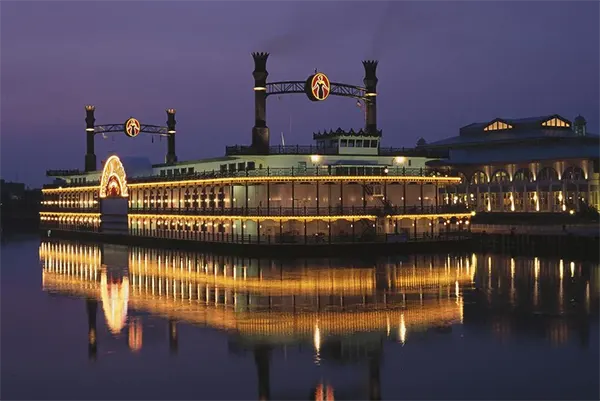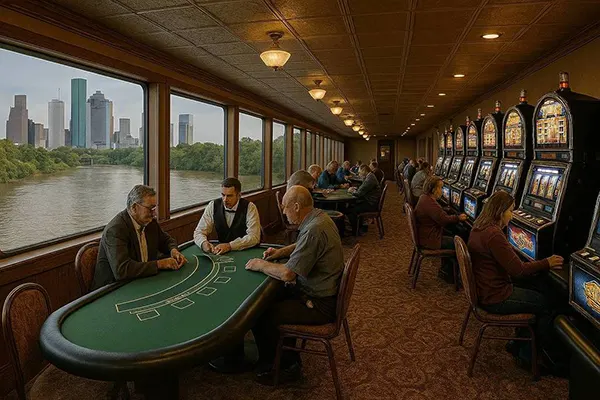Riverboat Casinos: Playing Blackjack on the Water — History and Modern Times

Riverboat casinos have long held a unique place in gambling culture, combining leisure cruising with the excitement of card games. Among the most popular options is blackjack, a game that has thrived both in historical riverboats of the Mississippi and in today’s modern entertainment venues. This article explores how these floating casinos developed, how blackjack became a central attraction, and how the tradition has been preserved into the twenty-first century.
The Origins of Riverboat Casinos
The concept of gambling on riverboats dates back to the early 19th century, when steamboats became a primary means of transport along the Mississippi River. These vessels carried not only goods and passengers but also card players who sought entertainment on long journeys. Gambling was often informal at first, with travellers playing blackjack, poker, and dice games to pass the time. The river soon developed a reputation as a hub for chance and fortune-seeking.
Blackjack, then known under various names such as “21,” became especially popular thanks to its simple rules and strategic elements. Riverboats provided the perfect setting, with players gathering in luxurious salons to try their luck. Although gambling was at times subject to legal restrictions, its presence on the water remained an iconic part of American culture.
By the late 19th century, gambling on riverboats had become more regulated, with organised games and dealers ensuring a structured environment. This set the foundation for the riverboat casinos that would re-emerge in the 20th century under more formal legal frameworks.
The Rise of Legalised Riverboat Gambling
During the late 20th century, several U.S. states introduced legislation that allowed casino-style gambling on riverboats. States such as Iowa, Illinois, and Mississippi pioneered this form of regulated entertainment. These floating casinos were often required to sail for a certain period during the day, a condition designed to maintain the traditional link between gambling and the river experience.
Blackjack tables quickly became a central attraction, with professional dealers, modern decks, and strict rules designed to protect fairness. Unlike in the 1800s, players now engaged in a highly structured version of the game, often with multiple tables and various betting limits. This made blackjack accessible both to casual participants and to more experienced strategists.
By the early 2000s, many restrictions on sailing requirements were lifted, but the riverboat model remained popular. It offered visitors a blend of history, nostalgia, and modern gaming convenience that land-based casinos often could not replicate.
Blackjack as the Heart of the Experience
Blackjack holds a unique place within riverboat gambling because of its combination of skill and chance. While slot machines dominate in terms of numbers, blackjack has consistently attracted players who appreciate its balance of mathematics and human psychology. On riverboats, the game also carried a sense of tradition, connecting modern players to their 19th-century counterparts.
One reason for blackjack’s enduring appeal is its relatively low house edge when played with proper strategy. This element of fairness contributed to the game’s reputation as a serious pursuit rather than a simple pastime. Riverboat operators often highlighted blackjack in their promotions, knowing it drew both seasoned card players and newcomers curious to learn.
In addition to the standard game, many riverboats began offering variations such as Spanish 21, Blackjack Switch, or bonus side bets. These alternatives kept the game fresh while preserving its fundamental mechanics. The adaptability of blackjack made it an ideal choice for the evolving environment of riverboat casinos.
Atmosphere and Player Interaction
Another defining aspect of blackjack on riverboats was the atmosphere. Unlike the anonymity often associated with large casinos, riverboat gambling provided a more intimate environment. Tables were closer together, and players frequently interacted with one another and with dealers. This social factor played a large role in the game’s popularity.
The setting of the river added an additional layer of character. Players enjoyed not just the game itself but also the backdrop of moving water, passing landscapes, and the historic aura of the vessel. For many, blackjack was as much about the overall experience as it was about winning hands.
Today, modern riverboat casinos continue to emphasise this element of community. Live dealers, themed interiors, and entertainment programmes help maintain the balance between gaming and social enjoyment that has defined riverboat blackjack for generations.

The Modern Era of Riverboat Casinos
In 2025, riverboat casinos still operate in several U.S. states, though their format has evolved. Many vessels are permanently moored and resemble land-based casinos in terms of facilities, yet they retain their riverboat designation due to state legislation. Blackjack remains one of the core attractions, ensuring the continuity of this tradition.
Modern riverboat casinos often integrate advanced technology into their gaming floors. Electronic blackjack tables, cashless payment systems, and loyalty programmes have become common. These innovations aim to enhance convenience while preserving the authenticity of the game. Importantly, blackjack rules and fairness standards are now tightly regulated by state gaming commissions.
Tourism has also played a crucial role in sustaining riverboat casinos. Travellers from across the United States and abroad visit these venues to connect with a piece of American history. Blackjack tables remain at the centre of this cultural appeal, bridging the past with present-day entertainment.
Looking Ahead: The Future of Blackjack on the Water
The future of riverboat blackjack appears stable, though adaptations will continue. Environmental concerns, economic pressures, and shifting consumer preferences may encourage further modernisation. Operators are expected to invest in sustainable energy, digital gaming integration, and hybrid entertainment options that blend live and electronic experiences.
At the same time, the historical charm of riverboats ensures that blackjack will likely remain a defining feature. The blend of strategy, social interaction, and historical significance offers something that cannot easily be replicated elsewhere. For many players, the act of sitting at a blackjack table on a riverboat remains a symbol of continuity between generations.
Ultimately, riverboat blackjack reflects more than just a game; it embodies the enduring relationship between culture, history, and entertainment. As long as rivers flow and communities value tradition, the story of blackjack on the water will continue to evolve.
